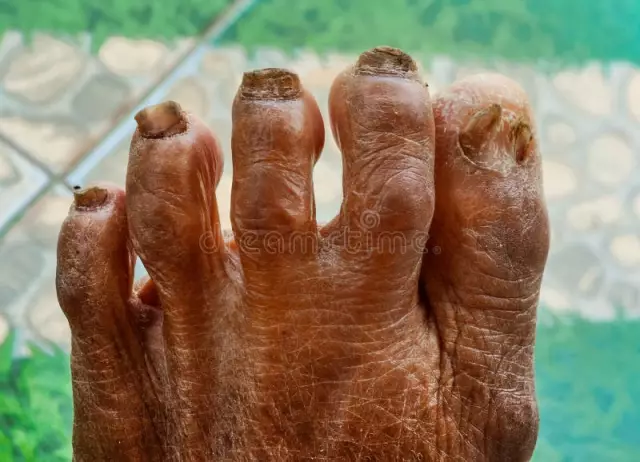- Author Rachel Wainwright [email protected].
- Public 2023-12-15 07:39.
- Last modified 2025-11-02 20:14.
12 common foot diseases
According to statistics, an ordinary person travels more than 100 thousand kilometers in his entire life. Of course, the exact distance depends on many factors (lifestyle, gender, profession, fitness, temperament, etc.). One thing is clear: the feet of our feet are constantly under stress that can negatively affect their condition. Today we will talk about those foot diseases to which people are most susceptible.

Source: depositphotos.com
Achilles tendonitis
The Achilles tendon is attached with its lower end to the posterior surface of the calcaneus, and the upper end to the gastrocnemius muscle. It provides movement of the ankle joint associated with walking and movement on an incline.
With the appearance of microtraumas of the tendon fibers, an inflammatory process develops, which is called tendinitis. Pathology is characterized by severe pain, a burning sensation in the affected area, as well as swelling of the calf of the leg and skin tightness. There is a limitation of the ankle mobility, the person begins to limp.
Despite the fact that the Achilles tendon is one of the strongest ligaments, it is under such severe stress that it is often damaged. At risk:
- athletes - the tendon is often injured during intense training;
- patients with metabolic disorders, in which urates (uric acid salts) accumulate in the body. Urates crystallize in tissues (including the fibers of the ligamentous apparatus), which reduces their elasticity and increases the risk of microtrauma;
- overweight people.
People with flat feet and clubfoot are more likely to develop tendonitis, and it increases with age.
If symptoms of Achilles tendon inflammation appear, an urgent need to consult a doctor. At the initial stage of the disease, the ankle is usually fixed. Conservative treatment consists in the use of anti-inflammatory and analgesic drugs, usually in the form of external agents (ointments, rubbing) and physiotherapy procedures. In the case of severe injury, surgery is indicated.
Bursitis of the thumb
With the constant wearing of shoes that have too narrow toes, a specific curvature of the big toes develops. In this case, the first phalanges, as it were, are inverted, moving away from the rest of the fingers, while the second phalanges deviate in the opposite direction. As a result, the joint located between the phalanges is displaced, its normal functioning is impaired. There is an inflammation of the joint capsule (bursitis), which is characterized by pain and swelling. The joint swells, pain appears when walking.
A similar injury to the little toes (the so-called tailor's bone) is observed in people who sit for long periods every day, keeping their legs crossed in the lower leg area. It is also accompanied by pain and swelling, which makes it difficult to fit shoes. Both pathologies are treated almost exclusively by surgery.
Corns and calluses
Calluses (areas of keratinized skin), as a rule, appear as a result of wearing shoes with too high heels, very tight or too loose shoes. Such formations occur on those areas of the feet that are subjected to the strongest stress (for example, on the lateral surfaces of the thumbs or little fingers). Soft calluses can develop on the ball of the feet and between the toes for similar reasons, which harden and harden over time. Corns are not only a cosmetic defect. They often interfere with walking, cause pain and increased leg fatigue.
There are pharmaceutical preparations with which you can get rid of corns and calluses, but you should not use them without consulting a doctor. It is especially dangerous to try to cut off the keratinized skin on your own. If calluses or corns become a problem, you should seek specialized help.
Hammer toe
This is a specific deformity in which the toes are bent and fixed, taking the shape of claws. The second fingers are most often affected. The cause is muscle weakening, which often occurs against the background of bursitis of the thumbs. The situation is aggravated if a person wears tight shoes or too tight socks.
In the initial stages, the pathology can be corrected with the help of special inserts and interdigital pads, which should be selected by an orthopedic surgeon. In advanced cases, you have to seek the help of a surgeon.
Heel spur
A heel spur is an overgrowth of tissue where the plantar tendon attaches to the heel bone. It usually occurs against the background of metabolic disorders (for example, gout). Risk factors are circulatory disorders, arthritis and excess weight. The spur can exist for a long time without causing any inconvenience. But in some patients, the growth periodically becomes inflamed, causing pain that gets worse when walking. The inflammation sometimes goes away on its own, but more often it requires treatment to correct it. In severe cases, steroid injections are used. In addition, with a heel spur, doctors recommend wearing instep supports and doing special exercises that help reduce the load on the ligamentous apparatus.
Ingrown nail
Sometimes the corners of the nail plates grow into the skin of the toes. As a result, areas are formed that are painful when pressed and create unpleasant sensations when walking. The problem requires an immediate solution, since the ingrowth zones are prone to inflammation.
Improper nail care is considered the most common cause of the disease, but it can also occur after a nail injury, and against the background of fungal infections of the skin of the feet. People who choose tight shoes are at risk (it's not for nothing that women suffer from ingrown nails one and a half times more often than men).
The surgeon should treat the ingrown toenail. Attempts to solve the problem on your own can lead to injury to the skin and infection of the wound.
Neuroma
When wearing improperly matched (tight or loose) shoes or excessive stress, an overgrowth of the nerve tissue occurs, located between the third and fourth toes of the foot. The disorder may not cause discomfort to the patient, but sometimes results in numbness, tingling, or mild burning. Less commonly, a neuroma manifests itself as pain in the sole and toes. In such cases, medical treatment is recommended, as well as the wearing of orthopedic devices.
Plantar fasciitis
The disease is an inflammation of the connective tissue of the soles and usually manifests itself with not too intense, but obsessive pain. Only a doctor can diagnose plantar fasciitis. Treatment takes at least six months. Medication, physical therapy, and regular foot fixation (usually at night) are prescribed.
Plantar wart
This is a formation that develops on the soft part of the sole. A wart is similar to a corn, but, unlike it, is capable of invading tissues. Gradually, it thickens and begins to cause sharp pain when walking. A plantar wart is caused by a viral infection. Getting rid of a problem is not easy. It is necessary to consult a doctor who will choose a method of treatment (drug therapy, cauterization with nitrogen, etc.).
Sesamoiditis
Sesamoid are two small, fragile bones located in the thickness of the tendons that allow the big toe to flex. Weakening of the tendon tissues and excessive stress on the foot can lead to fracture of these bones and the development of an inflammatory process in the surrounding tissues (sesamoiditis). Pathology is manifested by pain and swelling of the sole near the big toe. X-ray examination is necessary for accurate diagnosis. Treatment consists of applying anti-inflammatory and pain relievers. The affected leg should be kept at rest, periodically applying compresses with ice. In the rehabilitation period, wearing an instep support is shown.
Fatigue fracture
With prolonged exertion, so-called fatigue fractures of the foot bones occur. They are small cracks (usually in the metatarsal bones). People who are forced to be on their feet for a long time every day and wear shoes that are too loose are at risk of getting such injuries.
A fatigue fracture heals quickly at rest. The danger of damage consists primarily in the impossibility of self-diagnosis. With continued loads, the crack can expand, forming a real fracture, which will require prolonged immobilization and subsequent rehabilitation.
Mycoses
Fungal infections of the nails and skin of the feet are a very common problem. It is very easy to catch an infection: just put on the sick person's slippers or use his foot towel. There is a risk of infection when visiting a public pool, bathhouse or beach.
Nail fungus disrupts the structure of the nail plate. It changes color, becomes cloudy, thick and brittle. Sometimes the nail flakes off from its bed. The affected finger hurts and interferes with walking. The disease is difficult to treat and takes a long time (up to six months). Sometimes surgical removal of the nail is required.
Epidermophytosis is caused by a fungus that damages the skin of the feet (most often in the interdigital region). It becomes loose; weeping areas appear, emitting an unpleasant odor. Lesions are treated with external agents (sprays and lotions), but in severe cases, general therapy is used.
No one is immune from foot diseases, but everyone can reduce the risk of their occurrence. In this sense, it is important to carefully follow the rules of personal hygiene: keep your feet clean, use a cream to soften the skin, as well as powders and lotions that reduce sweating. It is necessary to choose the right footwear (especially everyday ones) and follow the recommendations of doctors regarding the wearing of orthopedic devices, if necessary.
Any problem with feet requires qualified assistance. Self-medication attempts usually only exacerbate the situation, which is fraught with long-term disability and a decrease in the quality of life.
YouTube video related to the article:

Maria Kulkes Medical journalist About the author
Education: First Moscow State Medical University named after I. M. Sechenov, specialty "General Medicine".
Found a mistake in the text? Select it and press Ctrl + Enter.






